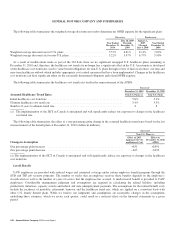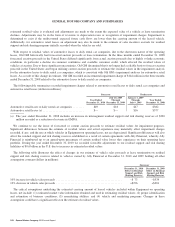General Motors 2010 Annual Report Download - page 109
Download and view the complete annual report
Please find page 109 of the 2010 General Motors annual report below. You can navigate through the pages in the report by either clicking on the pages listed below, or by using the keyword search tool below to find specific information within the annual report.GENERAL MOTORS COMPANY AND SUBSIDIARIES
model. Incentive programs are generally brand specific, model specific or region specific, and are for specified time periods, which
may be extended. Significant factors used in estimating the cost of incentives include the volume of vehicles that will be affected by
the incentive programs offered by product, product mix and the rate of customer acceptance of any incentive program, and the
likelihood that an incentive program will be extended, all of which are estimated based on historical experience and assumptions
concerning customer behavior and future market conditions. When an incentive program is announced, the number of vehicles in
dealer inventory eligible for the incentive program is determined, and a reduction of Automotive revenue or increase to Automotive
cost of sales is recorded in the period in which the program is announced. If the actual number of affected vehicles differs from this
estimate, or if a different mix of incentives is actually paid, the reduction in Automotive revenue or increase to Automotive cost of
sales for sales incentives could be affected. There are a multitude of inputs affecting the calculation of the estimate for sales
incentives, and an increase or decrease of any of these variables could have a significant effect on recorded sales incentives.
Policy, Warranty and Recalls
The estimated costs related to policy and product warranties are accrued at the time products are sold, and the estimated costs
related to product recalls based on a formal campaign soliciting return of that product are accrued when they are deemed to be
probable and can be reasonably estimated. These estimates are established using historical information on the nature, frequency, and
average cost of claims of each vehicle line or each model year of the vehicle line. However, where little or no claims experience exists
for a model year or a vehicle line, the estimate is based on long-term historical averages. Revisions are made when necessary, based
on changes in these factors. These estimates are re-evaluated on an ongoing basis. We actively study trends of claims and take action
to improve vehicle quality and minimize claims. Actual experience could differ from the amounts estimated requiring adjustments to
these liabilities in future periods. Due to the uncertainty and potential volatility of the factors contributing to developing estimates,
changes in our assumptions could materially affect our results of operations.
Accounting Standards Not Yet Adopted
Accounting standards not yet adopted are discussed in Note 4 to our consolidated financial statements.
Forward-Looking Statements
In this report and in reports we subsequently file with the SEC on Forms 10-K and 10-Q and file or furnish on Form 8-K, and in
related comments by our management, we use words like “anticipate,” “believe,” “continue,” “could,” “designed,” “effect,”
“estimate,” “evaluate,” “expect,” “forecast,” “goal,” “initiative,” “intend,” “may,” “objective,” “outlook,” “plan,” “potential,”
“priorities,” “project,” “pursue,” “seek,” “should,” “target,” “when,” “would,” or the negative of any of those words or similar
expressions to identify forward-looking statements that represent our current judgment about possible future events. In making these
statements we rely on assumptions and analyses based on our experience and perception of historical trends, current conditions and
expected future developments as well as other factors we consider appropriate under the circumstances. We believe these judgments
are reasonable, but these statements are not guarantees of any events or financial results, and our actual results may differ materially
due to a variety of important factors, both positive and negative. These factors, which may be revised or supplemented in subsequent
reports on SEC Forms 10-K, 10-Q and 8-K, include among others the following:
• Our ability to realize production efficiencies and to achieve reductions in costs as a result of our restructuring initiatives and
labor modifications;
• Our ability to maintain quality control over our vehicles and avoid material vehicle recalls;
• Our ability to maintain adequate liquidity and financing sources and an appropriate level of debt, including as required to fund
our planned significant investment in new technology, and, even if funded, our ability to realize successful vehicle applications
of new technology;
• The effect of business or liquidity difficulties for us or one or more subsidiaries on other entities in our corporate group as a
result of our highly integrated and complex corporate structure and operation;
• Our ability to continue to attract customers, particularly for our new products, including cars and crossover vehicles;
General Motors Company 2010 Annual Report 107
























